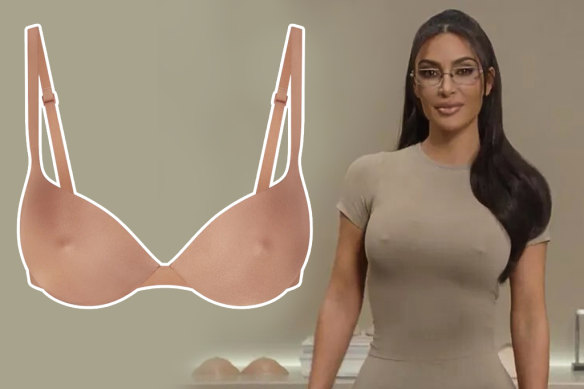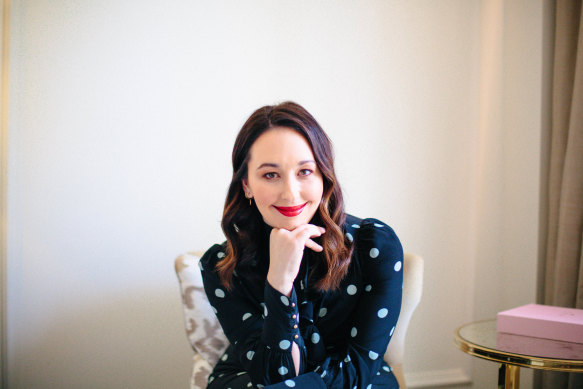This was published 1 year ago
For thousands of women, Kim Kardashian’s nipple bra could be more than just a gimmick
By Nell Geraets
When Kim Kardashian announced the upcoming launch of her shapewear label’s nipple push-up bra, the default reaction seemed to be either a collective groan or a knowing giggle.
“I’m introducing a brand-new bra with a built-in nipple, so no matter how hot it is, you’ll always look cold,” Kardashian said in the SKIMS product’s advertisement. “Some days are hard, but these nipples are harder. And unlike the icebergs, these aren’t going anywhere.”

Kardashian’s faux-nipple bra has raised eyebrows, but some breast cancer survivors say it could be a powerful self-confidence tool.Credit: SKIMS/Marija Ercegovac
For some, a push-up bra with fake nipples – retailing for $120 in Australia – marketed as a response to climate change, felt like a step too far, even for a social media mogul known for her gimmicks. But others have looked beyond the product’s initial absurdity, seeing it as a potentially life-changing option for breast cancer patients and survivors. Could there be more to this product than shock-value?
Shenae Curry Craig, a 32-year-old with stage 2 breast cancer, says she teared up when she first saw Kardashian’s advertisement.
“This was groundbreaking and I got emotional. I’ve been silently struggling with my body image since my diagnosis last year,” Craig says. “Through biopsies and chemotherapy, [my breasts] started to look different and now, after a double mastectomy, they are completely different – no feeling, no nipples ... I cried for days without telling anyone. It’s not about anyone seeing them, it’s psychological. The subconscious feeling that your nipples are there.”
Though aware the product is not explicitly targeted towards those with breast cancer, Craig says she finds comfort in seeing others like her express their excitment about wearing a bra that could make them “feel how [they] once felt”.
More than 20,000 people are diagnosed with breast cancer each year in Australia alone, according to Christobel Saunders, an oncologist and breast cancer specialist. Approximately 30 to 40 per cent have a mastectomy, about 15 per cent of which undergo breast reconstruction, but often without nipple reconstruction.
The life-saving procedure can have a significant impact on some people’s self-confidence and body image, says Krystal Barter, a women’s health advocate who had a preventative mastectomy at 25 after discovering she had the cancer-linked BRCA1 gene.
“Every day I miss my breasts and my nipples and everything that it looked like,” Barter says. “[The bra] has the potential to be useful or powerful for some women who have found it to be a really difficult process to go through, which it is.”
Notably, the utility of a fake-nipple bra differs significantly between individuals, says Dr Sophie Lewis, a senior lecturer in Sydney School of Health Sciences at the University of Sydney.
“There are many kinds of breast protheses to suit breast cancer survivors’ different needs, and this bra provides another option ... if this is something they wish to choose,” Lewis says.
“But I think it’s also important to keep in mind that, for some, showing the reality of their breast-free and nipple-free chests is important for representing and celebrating the full range of different kinds of bodies.”
However, if a faux-nipple bra makes someone feel better about themselves, they should be able to wear it without judgement, Barter says. In turn, that shouldn’t diminish others’ attempts to dismantle societal norms around breasts and nipples – there should be room for both, she says.

Krystal Barter thinks the new SKIMS faux-nipple bra could offer a powerful self-confidence boost for some breast cancer patients and survivors.
Regardless of its potential value among those with breast cancer and the fact that it was announced in October, which is Breast Cancer Awareness Month, the product’s advertisement campaign doesn’t touch on cancer at all. Some, like Craig, consider it “fun and inclusive by accident”, but others are more dubious about its tentative connection.
“Actual awareness around mastectomies would be more appreciated, or promoting more permanent solutions like 3D nipple-tattooing or transplants,” says metastatic breast cancer advocate, Katie-Marie Thorpe.
It has generated much conversation online, but Kardashian’s nipple bra isn’t the first of its kind. For example, Just Nips, founded by Molly Borman in 2017, sells reusable fake nipple prosthetics aimed primarily at breast cancer patients and survivors.
“Many women who don’t have nipples wear our products ... to raise awareness about some of the many side effects of breast cancer others don’t know about,” Borman says. “Women also wear our products to enhance the female form. We’ve had women write in to say how they wanted extra confidence on a first date, or even a job interview, and wore our products to feel their best.”
Lauren Rosewarne, an associate professor at The University of Melbourne who researches gender and feminism, says the “no-bra-look” has gone in and out of fashion through the years, stretching back to the ’60s and ’70s. It crescendoed in 2012 when the “free the nipple” campaign drew attention to the existing double standard between men and women’s nipples.
However, Rosewarne rejects any suggestion that the SKIMS nipple bra aligns with this kind of feminist movement.
“SKIMS is a business that’s about making money. Nods to feminism work as a vehicle to carve out an identity for the company,” she says.
Regardless, both Barter and Craig are curious to try the new perky product.
“A huge percentage of women make life-changing and saving decisions every day because they’re facing the threat of not only cancer, but a risk of cancer,” Barter says. “It changes their body and how they feel about it, and it’s directly tied to our breasts and our nipples and our identity.
“If the bra helps people, I think that’s a really powerful thing.”
Make the most of your health, relationships, fitness and nutrition with our Live Well newsletter. Get it in your inbox every Monday.